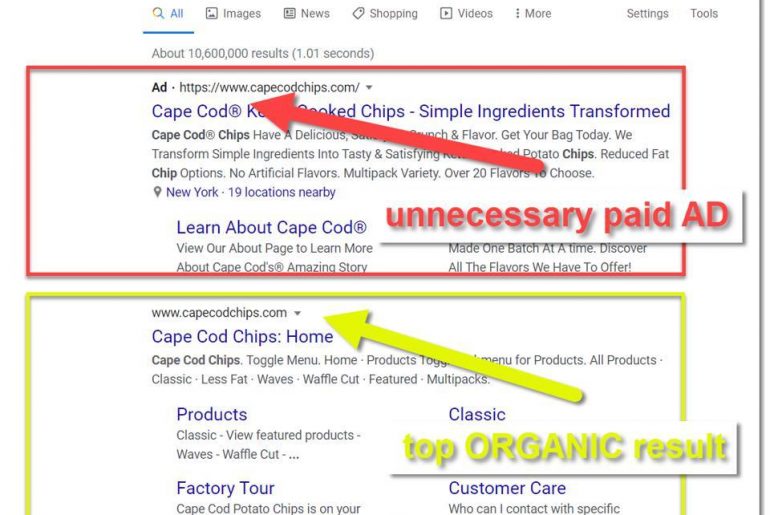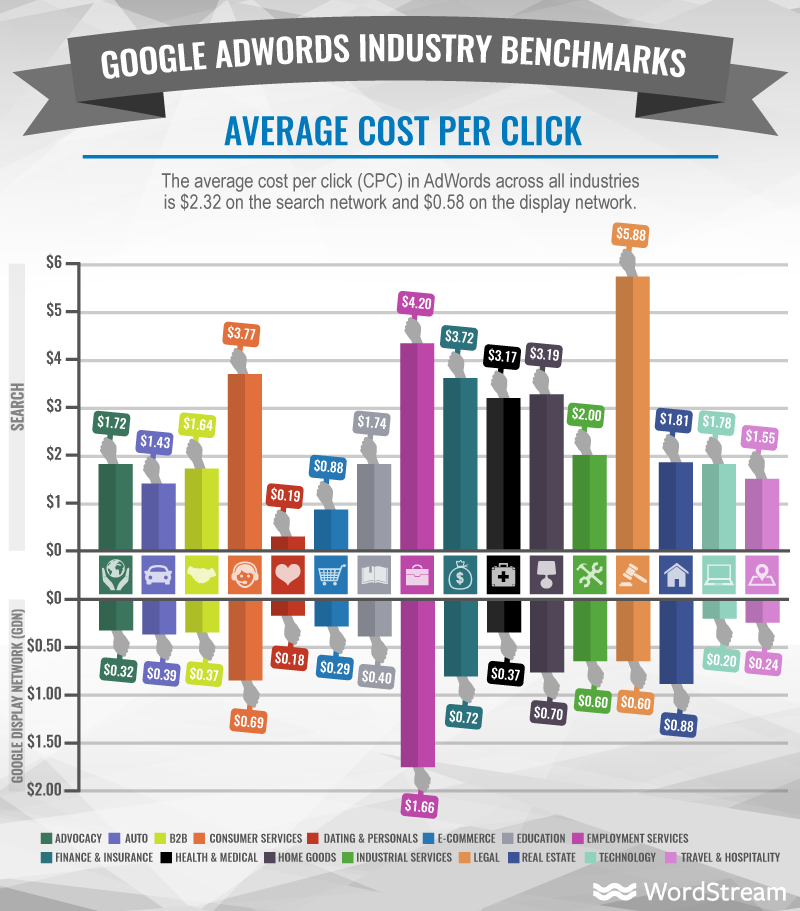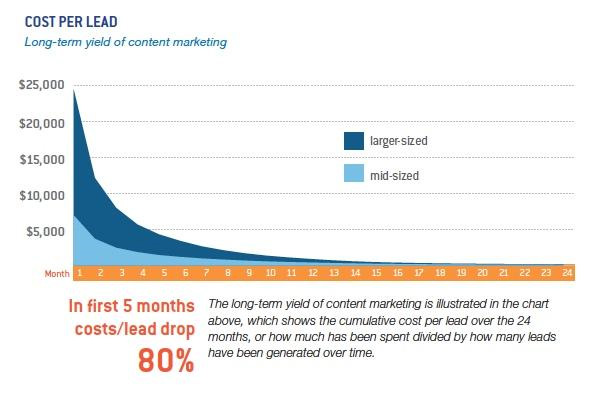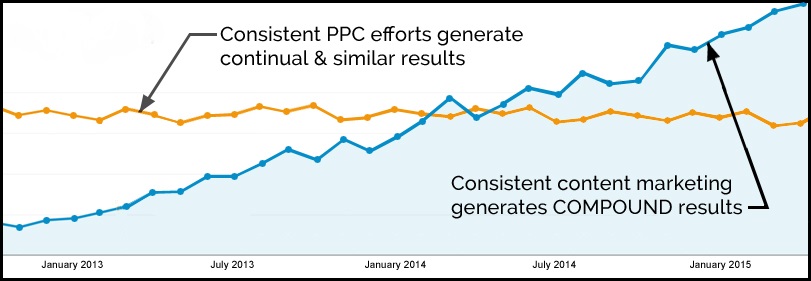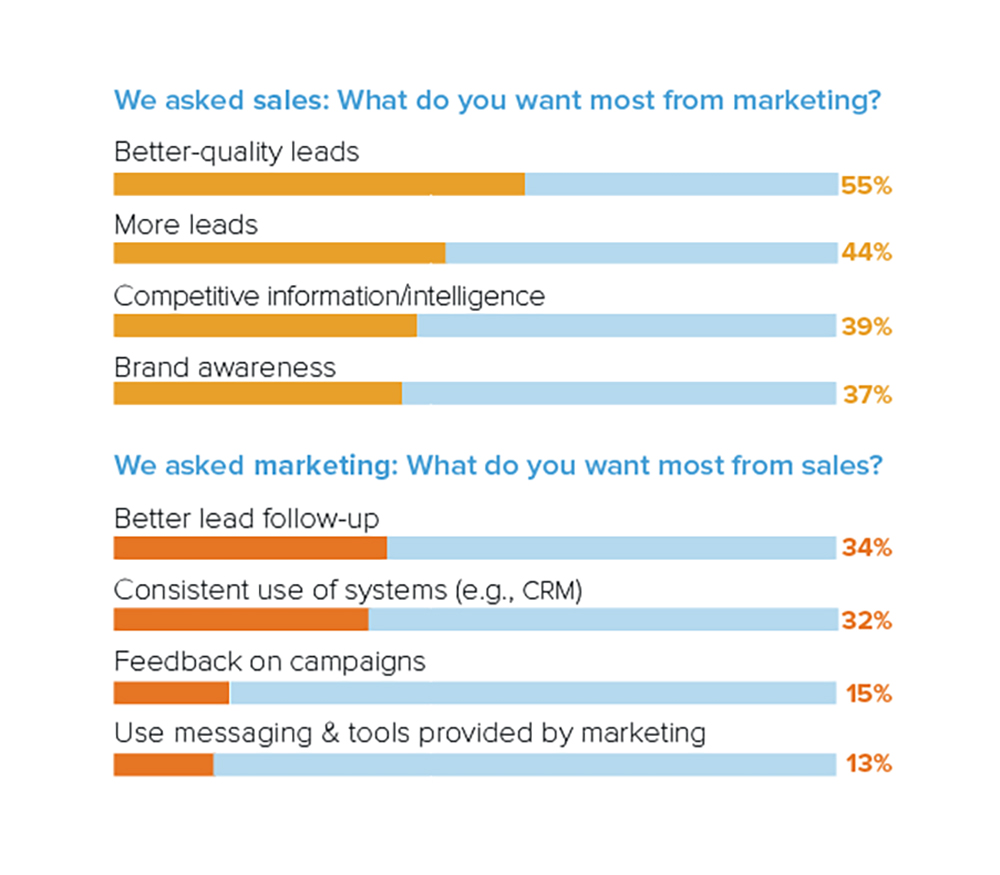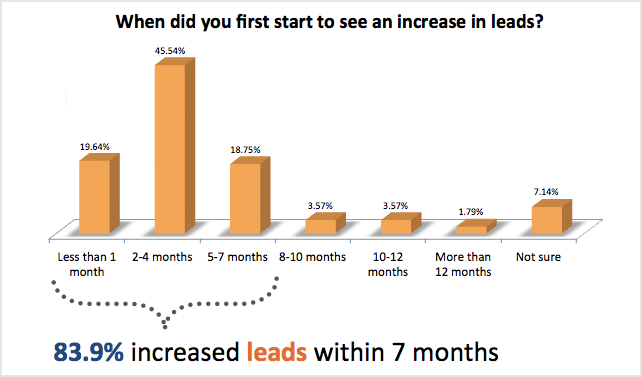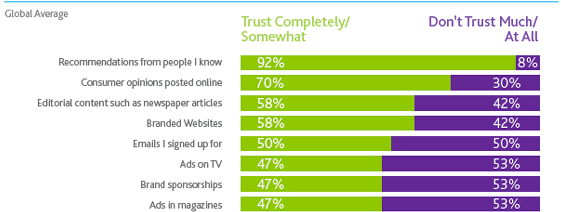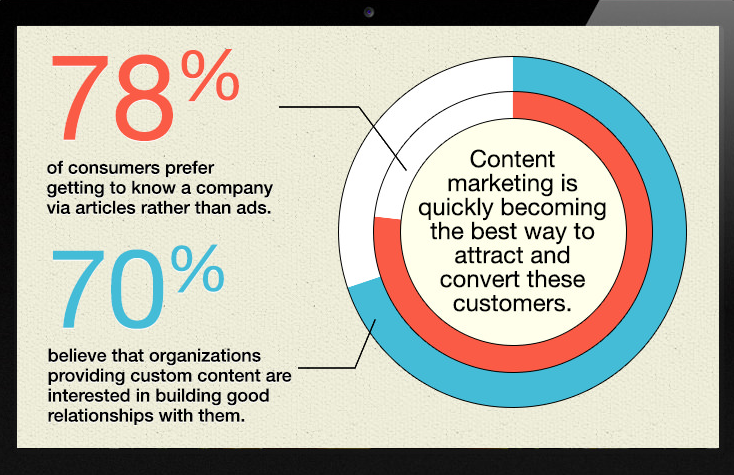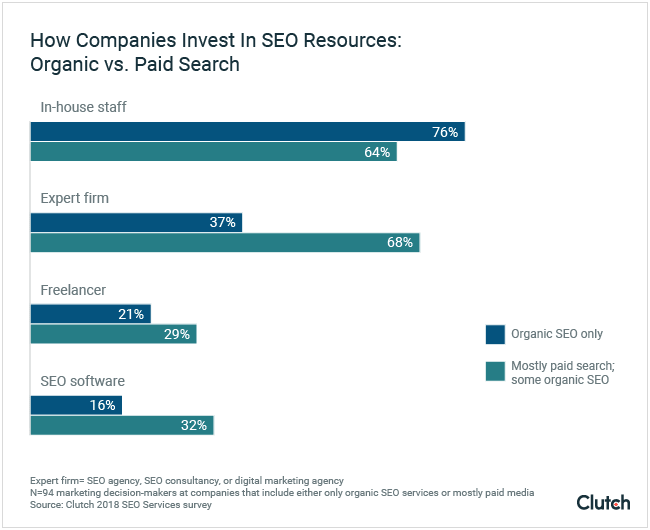The SEO services that businesses prioritize, the challenges they face, and the benefits they target determine how they structure SEO strategy.
How exactly do these factors shape businesses’ SEO strategy?
We partnered with Ignite Visibility (link is external), a leading digital marketing agency that specializes in both paid and organic SEO, and surveyed 300+ U.S. businesses to answer this question.
In particular, we examine the impact of focusing on paid search versus organic SEO services on businesses’ approach to SEO.
We also analyze how businesses prioritize SEO services to adapt to the new customer buying journey.
Our Findings
- Only 19% of businesses that invest in SEO focus on paid search.
- More companies will prioritize social media marketing (20%) than any other SEO service over the next 12 months.
- Nearly all businesses (94%) that invest in SEO also invest in social media.
- Two-thirds (66%) of businesses rely on in-house staff for SEO services.
- Over half of businesses (55%) partner with an expert firm for help with SEO services.
- The main challenge businesses experience with SEO is proving return on investment (25%).
Paid Search Complements Organic SEO
Most businesses that invest in SEO focus on organic services, or unpaid activities that you perform manually to improve search rankings for your website.
Examples of organic SEO services include:
- Content marketing
- Link building
- Optimizing individual web pages or categories
- Fixing technical errors that limit a website’s rankings
- Using social media marketing to promote pages
Over 40% of businesses focus on either mostly or only organic SEO. Fewer businesses (19%) focus on mostly paid search (source: https://scottkeeverseo.com/seo-tampa/).

The small percentage of firms that focus on paid search (19%) stands out to John Lincoln, CEO of Ignite Visibility. Lincoln identifies paid search as a good starting point for an effective search engine marketing strategy (paid and organic services), particularly for new websites.
In addition to the 19% of businesses that focus mostly on paid search, 39% focus on paid and organic services equally.
Paid search complements organic SEO services by providing feedback in areas such as:
- Keyword research
- Audience targeting
- Ad copy
- Synergy in relation to organic rankings
- Brand strength and organic click-through rates (CTRs)
“You get immediate feedback on several different pieces [from paid search]: The keywords that have the highest conversion rates, which type of audiences get the highest conversion rates, and which type of ad copy and landing page copy get the best results,” said Eythor Westman, Head of Paid Media at Ignite Visibility. “You can leverage that [information] to develop a more effective SEO strategy, rather than blindly deciding to target certain keywords for SEO.”
Lincoln agrees that paid search campaigns provide valuable insight that businesses can use to inform their organic strategy.
“While you will get a better ROI on organic search long-term, brand new websites should always start with paid. Even mature websites that get millions of visitors a month from organic should invest in paid. The two complement each other. Paid is a bit more precise and controllable,” said Lincoln. “Organic SEO drives the bulk of traffic online. It’s all about knowing the right time to use each one and when to use them together.”
Whether a business focuses on organic SEO versus paid search plays a major role in shaping its overall SEO strategy.
Below, we explore the impact of paid search and organic SEO on businesses’ SEO strategy.
SEO Services Priorities Reflect Changing Customer Journey
The SEO services that businesses prioritize reflect a recent shift in the customer buying journey. The new customer journey emphasizes mobile search (link is external) in addition to longer consideration and decision-making periods.
In 2018, Google expects to introduce a mobile-first index (link is external), in which search results will favor mobile-friendly sites. Adapting your site for mobile search improves search ranking and drives conversions.
“The ways that people convert on mobile are a lot different than how they convert on a desktop. The customer journey has totally changed. Now, somebody Googles a keyword. They click on a top ranking term like ‘SEO company.’ They read our blog and click on social media. Perhaps they subscribe to a newsletter or our YouTube channel. They also might look at review sites,” said Lincoln. “Then, they convert three weeks later, after they feel comfortable with you.”
“The customer journey has totally changed.” – John Lincoln, CEO, Ignite Visibility
Customers now use mobile devices to research potential business partners before converting on a product or service. They check out the business’s website, read blog content, and inspect social media posts.
One-fifth (20%) of businesses list social media marketing as a top SEO services priority over on-site optimization (16%) and creating content to earn links (15%).

The top SEO service priorities businesses listed — social media, on-site optimization, creating content, and mobile search optimization — position them well both for the new customer journey and Google’s new search guidelines.
Social Media Supports SEO Services & Facilitates the Customer Journey
Businesses consider social media a key element of their SEO strategies.
Social media correlates with search rankings (link is external): If you regularly post on social media about your business and target search terms, the chances that your posts appear on relevant search results increases. Social media helps build branded traffic and provides more exposure for content, which can result in more links.
In addition to the 20% of businesses that list social media as their primary SEO priority over the next 12 months, nearly all businesses that invest in SEO also invest in social media (94%).

SEO service providers agree on the importance of social media to an SEO strategy. Ignite Visibility, for example, provides social media services with all SEO services, according to Lincoln.
Social media facilitates the customer buying journey through various means:
- Reaching additional audiences
- Providing information about your company to audiences
- Increasing traffic and leads
- Allowing content to be found in social media search engines and feeds
“It takes between 7-13 touches to deliver a qualified sales lead,” said Scott Holstein, Marketing Manager for Computrols, Inc (link is external), a Louisiana-based building automation manufacturer, citing an Online Marketing Institute study on customers shifting conversion habits (link is external).
“We cannot simply depend on one source to reach [audiences],” said Holstein. “Someone may search for your service but not click on your result if they are not familiar with your brand. If you are already in their social feed, it’s likely that your [click-through rate] will increase as well.”
Social media increases businesses’ exposure and creates familiarity. This increases the possibility that audiences engage with your brand and convert into paying customers.
Businesses Rely on Both In-House and Expert Firms for SEO Services
Businesses depend on both in-house teams and expert firms for SEO services. Two-thirds (66%) of companies rely on in-house staff and 55% of businesses hire an SEO agency, SEO consultancy, or digital marketing agency.

The resources businesses turn to for SEO depends on whether they focus on organic services or paid search.
Over three-fourths (76%) of businesses that invest in only organic services rely on in-house staff. On the other hand, 68% of firms that invest in paid search partner with SEO experts.

Businesses that focus on organic SEO trust their in-house teams to drive SEO strategy. More than twice as many businesses that focus on organic services rely on in-house staff (76%) than an expert firm (37%) for SEO services.
In-House Staff Handle Social Media, Content Marketing
In-house SEO staff are often “jacks of all trade” marketers who are more familiar with general digital marketing efforts, such as social media and content marketing.
Companies that rely on in-house staff for SEO services invest heavily in social media marketing (82%) and creating content to earn links (73%).

In-house marketers often lack both the technical capabilities and time to carry out more complex SEO services such as on-site optimization and link-building.
The relative ease of social media marketing efforts makes it an investment target for in-house teams, says Rand Fishkin, a leading SEO thought leader and founder of Moz (link is external), an SEO software company.
“Social media is an easy-to-invest-in activity. You don’t need any engineering or dev resources – most executives have a basic grasp of it, so it gets resources and prioritization,” Fishkin said.
Lincoln said in many cases, businesses that depend heavily on in-house teams are either smaller in size and tend not to be serious about SEO or large businesses with sizable in-house teams.
“[In-house staff] usually have a more limited knowledge of link building or SEO. In almost every case, they’re a jack of all trades and also spread thin,” said Lincoln. “They do a little bit of content marketing, but they don’t know how to optimize it or how to report on it. They do a little bit of social media.
In-house teams create content that help businesses engage with their digital audiences. However, without the knowledge to optimize that content, it may still be difficult to actually find audiences to engage.
Expert SEO Companies Hired For Complex and Costly SEO Services
Businesses look to SEO experts for technically complex and costly services. Businesses that focus on paid search are more likely to hire an expert (68%) than use in-house staff (64%) for SEO services.
The “paid” aspect of paid search motivates businesses to partner with SEO experts.
Which type of SEO services providers work best for your firm? Learn more
With a pay-per-click campaign using Google AdWords, for example, companies are required to bid specific prices on their target keywords. Your company must understand how the AdWords platform works and have a bidding strategy in place.
While many businesses may have in-house knowledge of AdWords or PPC campaigns, expert PPC companies are typically more experienced and less likely to waste your company’s money on a misguided or mishandled paid advertising campaign.
Return on Investment Presents Main SEO Challenge
Businesses experience challenges tracking and proving key metrics for their SEO strategies. For 25% of businesses, the main challenge with SEO is proving return on investment (ROI).

The challenge of proving ROI aligns with the challenge businesses experience tracking analytics (17%) to determine the success of an SEO campaign.
The challenge of measuring ROI results from two different factors:
- Google’s mission to make measuring ROI difficult
- The disconnected nature of organic search traffic from actual customer conversions
“Google’s worked very hard to make [measuring ROI a challenge] by removing keyword data and making SEO a difficult-to-track channel,” said Fishkin. “Given how disconnected a search visit often is from a future conversion event (sometimes there’s multiple months and dozens of visits between a first-visit and a conversion), raw organic traffic is actually a sensible metric to use.”
Since the customer journey now consists of so many different points, proving the exact investment that drives conversions presents a significant challenge for businesses.
Tracking and measuring the best metrics and analytics may also prove a challenge for some companies that want to increase brand exposure rather than increase revenue through SEO services.
“Sometimes there are companies that don’t care about ROI. What they want is to rank for a couple of keywords. They want the brand exposure. Other companies need the technical assistance,” said Lincoln. “In other cases, ROI becomes an issue because the SEO company providing services does not have the ability to achieve ROI. Some companies, like ours, offer forecasts. That really helps set expectations.”
Best Practices Challenge Businesses That Focus on Paid Search
SEO challenges depend on whether a business focuses on paid search or organic SEO. For businesses that focus on paid search, 21% say their main challenge is maintaining best practices.

Maintaining best practices for paid search is particularly challenging given the consistent updates made to popular ad platforms.
For example, for a company using AdWords for a PPC campaign, the value of the keywords are subject to change: Companies need to stay alert to changing approaches to retain value from their campaigns.
Failure to stay aware of the most recent updates also threatens the ROI of a paid search campaign.
“With major changes that have come out, not adapting the campaigns to those best practices can result in a loss of returns. If you do not leverage [ad platforms] as effectively as possible to compete, you can start to get outbid,” said Eythor Westman.
Expert firms are aware of platform updates and understand how to use them to maintain the success of their clients’ campaigns.
Businesses that fail to keep up with updates or other industry shifts risk losing out on target keywords and other paid ad opportunities.
Services Priorities, Customer Behavior Shape SEO Strategy
Businesses shape SEO strategy based on their SEO services priorities, challenges, and changing consumer habits.
The impact each of these factors has on how businesses approach SEO depends on whether they focus on organic SEO or paid search.
Businesses that mostly focus on paid search are more likely to partner with an expert firm for technically complex SEO services like link-building and on-site optimization.
In-house SEO staff, on the other hand, are “jacks of all trades” marketers that excel at general services like social media and creating content to earn links.
Finally, the shift in the customer buying journey drives businesses to prioritize SEO services that allow them to engage with increasingly mobile and informed consumers, particularly through investing in social media.



